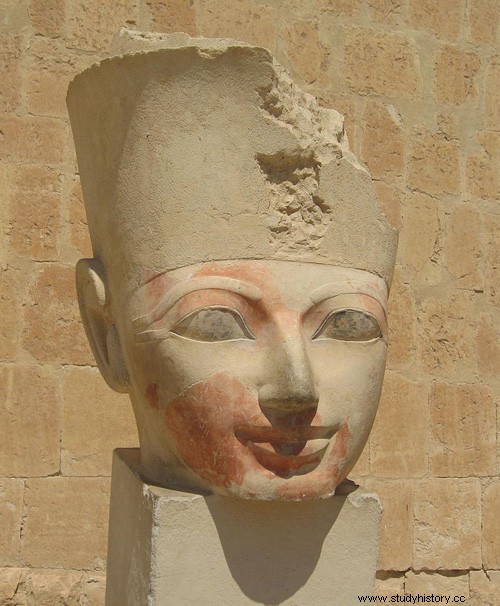Hatchepsout (between 1508 and 1495 BC – 1457 BC) is "king-pharaoh", belonging to the XVIII th dynasty of ancient Egypt. She reigns for twenty years alongside her husband's son, as king.
Royal Princess
 Daughter of the future pharaoh Thutmose I
st
and his Great Royal Wife and sister Ahmes, Hatshepsut was born in Thebes between 1508 and 1495 BC. Given by her mother in view of the delicacy of her face, her name means:“she is at the head of the noble ladies”. She is raised by a nanny. His father also has three sons with his secondary wife Moutnofret I
re
. Her parents also had a second daughter, Neferubity, who died young.
Daughter of the future pharaoh Thutmose I
st
and his Great Royal Wife and sister Ahmes, Hatshepsut was born in Thebes between 1508 and 1495 BC. Given by her mother in view of the delicacy of her face, her name means:“she is at the head of the noble ladies”. She is raised by a nanny. His father also has three sons with his secondary wife Moutnofret I
re
. Her parents also had a second daughter, Neferubity, who died young.
When Hatshepsut was eight or nine years old, Pharaoh Amenhotep I st dies without an heir and Thutmose succeeds him. Hatshepsut then becomes royal princess and receives the education that accompanies this title. The young girl is intelligent and her father educates her so that she can play an important role in the kingdom, taking her on trips and introducing her to high officials. A wall of the temple of Deir el-Bahari quotes him as saying:"I will put her in my place". His brothers, from a secondary wife, are also fragile and these elements may also have prompted the pharaoh to favor Hatshepsut.
Maatkare, King of Upper and Lower Egypt
Around the year VII of her father's reign, Hatshepsut married her half-brother Thutmose. This marriage ensures the succession to the future Thutmose II and makes Hatshepsut his future Great Royal Wife. Three or four years later, they have a daughter, Neferure, whom they entrust to a tutor. After more than twelve years of reign, Thutmose dies and his successor accedes to the throne. Her reign was brief, however, lasting only three years, during which Hatshepsut gave birth to a second daughter, Merytre-Hatshepsut. His successor Thutmose III, another son of Thutmose, was then still a child and Hatshepsut became regent of the kingdom. The walls of the tomb of Ineni, mayor of Thebes, report:"His sister, the wife of the god Hatshepsut, conducted the affairs of the country according to her own will. The Two Lands were subject to her will and served her. »
Hatshepsut takes the name of Maâtkare, king of Upper and Lower Egypt , while the young king is called Sa-Rê (son of the sun). Around year III of the reign of Thutmose III, without the reasons being clear, she was crowned king. The ceremony does not follow the traditional rites but receives the support of the clergy of Amon. Following her coronation, she wears, during ceremonies, the male attributes of royalty:loincloth, headdress, artificial beard. However, she continues to number her years of reign with the numbering of Thutmose III, whom she does not dispute as king. The throne is shared between the two sovereigns.
The reign of a builder
Hatshepsut reigns for about twenty-two years, between 1479 BC and 1457 BC. His reign was mostly peaceful, marked by a growth in trade (in ivory, ebony, cedar wood, oils, incense, copper, turquoise, etc.). It establishes trade routes, opens mines, finances expeditions. She also launched a military campaign against Nubia to replace the viceroy and, perhaps, against Palestine. A great builder, she initiated many construction projects, obelisks, monuments and chapels. It also produces numerous statuaries, and restores temples.
Hatshepsut died in her twenty-second regnal year, aged about fifty. She is not buried in her tomb as a Great Royal Wife, initiated during her husband's short reign, but in a pharaoh's tomb. Towards the end of Thutmose III's reign, attempts were made to remove Hatshepsut's name from documents, monuments, and statues representing her were smashed. This attempt at erasure was perhaps intended to restore her to the status of a mere regent rather than a king.
